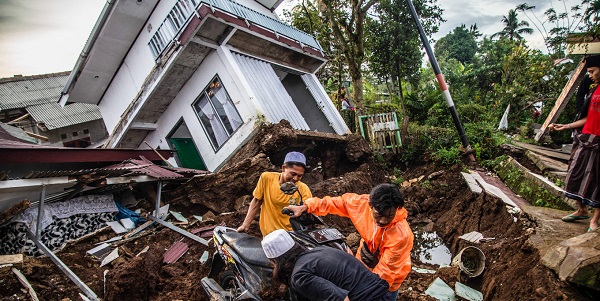Shallow Earthquakes- Why are they more Dangerous?

From Current Affairs Notes for UPSC » Editorials & In-depths » This topic
IAS EXPRESS Vs UPSC Prelims 2024: 85+ questions reflected
Recently, Indonesia witnessed a relatively small earthquake that claimed a disproportionate number of lives, apart from damaging thousands of buildings. In this context, the world cities’ preparedness against shallow quakes gains importance.

Cianjur Earthquake:
- On November 21st, a 5.6 magnitude earthquake hit the Cianjur city of West Java, Indonesia. It recorded an 8 on the Modified Mercalli Intensity scale.
- While this earthquake is much smaller compared to the many others faced by the country that lies in the Pacific Ring of Fire, it killed some 268 people and damaged over 22,000 buildings.
- One of the key reasons for this is that the quake struck very close to the surface, i.e. just 10 km underneath the earth’s surface.
What are shallow earthquakes?
- An earthquake’s magnitude and the depth of its focus determine the intensity of shaking.
- A large earthquake originating at a depth of over 50 km could cause widespread damage, but the intensity of the shaking is subdued and rarely cause large fatalities. Such earthquakes are considered as ‘deep quakes’.
- Eg: In 2016, a 6.8 quake originating at a depth of 84 km, hit Myanmar.
- The 2017 Tasikmalaya earthquake, originating at a depth of 90 km and with a 6.5 magnitude, killed only 4 people.
- On the other hand, earthquakes that originate closer to the ground are called ‘shallow quakes’. These are more damaging than deep quakes.
- Eg: in 2016 (around the same time as the Myanmar earthquake), a magnitude 6 quake struck Italy, but with far more damage.
Why are they more dangerous?
- In case of deep quakes, the seismic waves have to travel a longer distance before reaching the surface. During this period, they lose energy to the surroundings.
- However, in case of shallow quakes, the seismic waves are able to bring much more energy to the surface and consequently, more damage.
- As inland shallow quakes are infrequent occurrences, many people remain oblivious to its dangers. For instance, throughout the 20th century, Java witnessed just one massive shallow quake in 1924 that caused some 800 deaths and another 4 quakes that claimed 10-100 lives. During this period, the region’s population rose 4-fold. This is due to the lack of lived-experience of a major quake among the newer generations.
- As a result, insufficient attention is paid to making the residential developments earthquake-resilient.
- Apart from this, the damage caused by an earthquake depends on multiple variables like:
- Distance from the earthquake
- Type of soil in the area
- Building construction
- Population density, etc.
What can be done?
- The recent Cianjur quake should serve as a wake-up call for policymakers, in Indonesia and other earthquake prone countries, to improve building practices.
- The first step is to improve and enforce the building codes already in place. Indonesia already has building codes, informed by modern seismic hazard maps, in place. However, these norms are applicable only to buildings with 8 or more floors.
- Apart from this, Indonesian authorities face the obstacle of high poverty levels impeding universal enforcement of these norms.
- In such cases, simple, minimum standards could be introduced to improve the level of protection. These standards could cover basics like:
- Concrete strength
- Reinforcement quality, etc.
- The ongoing and upcoming constructions should be stringently vetted for conformance with the codes.
- In addition to this, there is a need for cultural change. People should start expecting more of builders, when it comes to earthquake-resilience. Customers must prioritize such measures and be ready to invest in it.
Conclusion:
Shallow quakes, though infrequent, are decidedly deadlier given the development of cities in the Ring of Fire countries. Such dangerous earthquakes hitting major population centers in earthquake-prone countries isn’t a question of if, but when. It is high time to bring in at least minimum standards to govern buildings’ earthquake-resilience.
Practice Question for Mains:
What are shallow earthquakes? Why are they deadlier than the deep quakes? How can cities prepare for events like the Cianjur quake? (250 words)
If you like this post, please share your feedback in the comments section below so that we will upload more posts like this.

